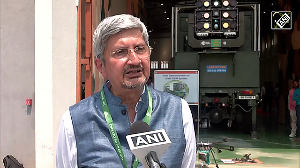India's maiden moon mission, Chandrayaan-1, will carry two instruments from the American space agency National Aeronautics and Space Administration which will assess mineral resources and map the polar regions and look for ice deposits.
The American agency said the data from the two instruments Mineralogy Mapper and Miniature Synthetic Aperture Radar (Mini-SAR) will contribute to its understanding of the lunar environment and are part of its implementation of its space exploration policy which calls for robotic and human missions to the moon.
"The opportunity to fly NASA instruments on Chandrayaan-1 undoubtedly will lead to important scientific discoveries," NASA Administrator Michael Griffin said.
"This exciting collaboration represents an important next step in what we hope to be a long and mutually beneficial relationship with India in future civil space exploration."
The Moon Mineralogy Mapper is a state-of-the-art imaging spectrometer that will provide the first map of the entire lunar surface at high spatial and spectral resolution, revealing the minerals that make up the moon's surface.
Scientists will use this information to answer questions about the moon's origin and geological development, as well as the evolution of terrestrial planets in the early solar system. The map may also be used by astronauts to locate resources, possibly including water, that can support exploration of the moon and beyond.
India's mission is carrying a Moon Impactor Probe, the brainchild of former President and scientist APJ Abdul Kalam, which will detach from the spacecraft and land on the moon.
The Mini-SAR is a small imaging radar that will map the permanently shadowed lunar polar regions, including large areas never visible from Earth. The Mini-SAR data will be used to determine the location and distribution of water ice deposits on the moon.
Data from the instrument will help scientists learn about the history and nature of objects hitting the moon, and the processes that throw material from the outer solar system into the inner planets.
In addition to the two science instruments, NASA said it will provide space communications support to Chandrayaan-1.
The primary location for NASA's ground tracking station will be at the Johns Hopkins University Applied Physics Laboratory in Laurel, Maryland.
India will be the fourth country after the US, Russia, and Japan to have its flag on the moon.







 © 2025
© 2025